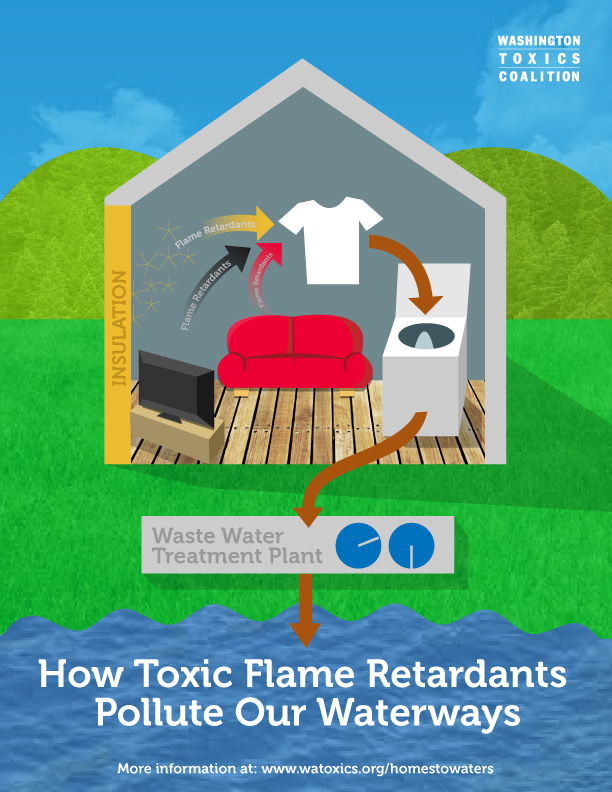I recently wrote about toxic chemicals commonly used in household laundry detergents and dry cleaning. One class of chemicals I didn’t talk about in that piece was toxic flame retardants. I didn’t think there was a connection to our laundry… until new compelling research came out indicating otherwise. Toxic flame retardants: they’re everywhere.
A study published in the journal Environmental Science and Technology (subscription required), found that U.S. waterways are polluted by toxic flame retardants citing household laundry as an important source. The study also found that current waste water treatment facilities are doing very little to filter out contaminants, including flame retardant chemicals. The result is widespread environmental exposure to toxic flame retardants in drinking water, mammals and aquatic life.
What are flame retardants?
Flame retardants are a class of chemicals introduced on to the market in the 1970s with the idea that they would slow and prevent household fires. Decades later we’ve learned that they don’t prevent fires, but that they are highly toxic, entering our bodies at alarming rates and are linked to cancer, hormone-disruption and harming the brain. One of our biggest routes of exposure in our homes is through the seemingly innocuous household dust, couches and children’s products.
According to the scientists at the Washington Toxics Coalition, flame retardants were first detected in Swedish rivers in 1981, just a few years after the chemicals were introduced widely on the market.
As part of this study, the Washington Toxics Coalition sought to find out if household laundry was a source of the toxic flame retardant water pollution. Here’s what they set out to do…
How researchers set up the study:
- The study asked 20 households to participate in the study.
- Researchers took samples of household dust from their homes and tested them for flame retardants.
- They asked participants to submit dirty clothes that were worn around the home.
- They tested the water after doing a load of laundry.
- They tested input and output water at waste water treatment facilities for flame retardants.
What they found:
- Widespread exposure to flame retardants in household dust: 21 total flame retardants were detected, 16 of which were present in 95% of the homes.
- 18 flame retardants were detected in laundry water after washing clothing worn around the home.
- One class of flame retardants “tris compounds” dominated the test results. You may remember this type of flame retardant which was removed from children’s pajamas in the 1970s over health concerns and yet is still widely used in couches and furniture in our homes.
- The levels of flame retardants entering waste water treatment facilities closely matched the levels found in the laundry water samples.
- Similar levels of flame retardants were found as water exited the waste water treatment facilities, showing that current technology is not equipped to filter out industrial chemicals commonly used in household products.
- Fish and sediment in the Columbia River have tested for flame retardants and other chemicals of concern for over a decade; with levels sharply rising in the early 2000s leading to fertility problems in osprey populations.
Read more about the report on the Washington Toxics Coalition website.
What it all means:
This new research sheds important light on the journey many seemingly “harmless” toxic chemicals take from our products, homes, bodies and environment. The chemical industry would like us to believe that chemicals and ingredients stay put in products, but there is a mountain of evidence that shows us that simply isn’t the case.
What we can do:
- This week Senator Chuck Schumer from New York introduced a bill that would ban 10 toxic flame retardants in furniture and children’s products. Call your Senators and tell them you support this bill (Senate bill #2811). Capitol switchboard: 202-224-3121
- Shop for flame retardant free furniture.
- Make dusting and vacuuming a routine part of your cleaning regime. Reduce household dust, one of our major routes of exposure (and now environmental pollution).
- Buy a vacuum with a HEPA filter, this is the best way to trap toxic flame retardants.
- Use microfiber cloths such as E-cloths to dust your home (no need to use chemical sprays).
- Wash hands before eating to reduce hand to mouth exposure to flame retardants.
- Wash hands after handling dryer lint.
- Read my other tips to ensure less toxic laundry soap and dry cleaning.
- Share this information on Twitter by retweeting below!
New study finds flame retardants enter waterways via household laundry, learn more >> https://t.co/nguE6cGJWX via @WA_Toxics
— Lindsay Dahl (@LindsayDahl) September 19, 2014
Join my mailing list and never miss a post.




